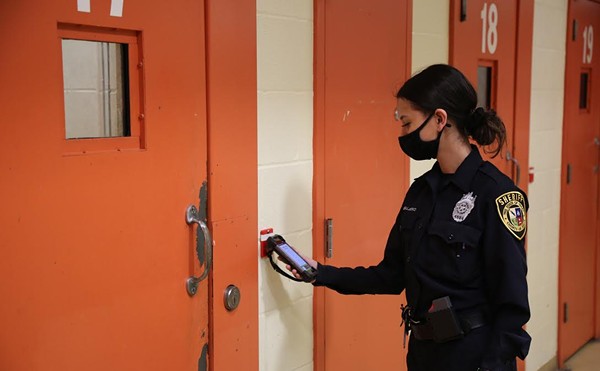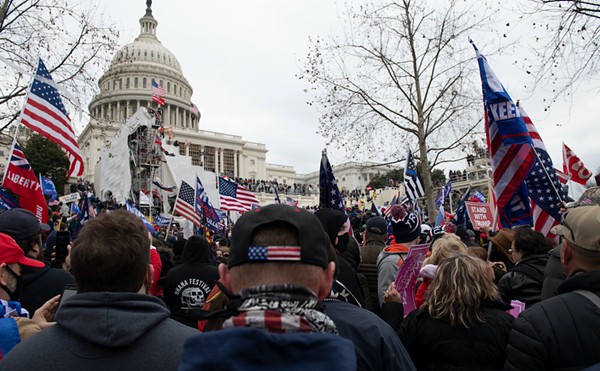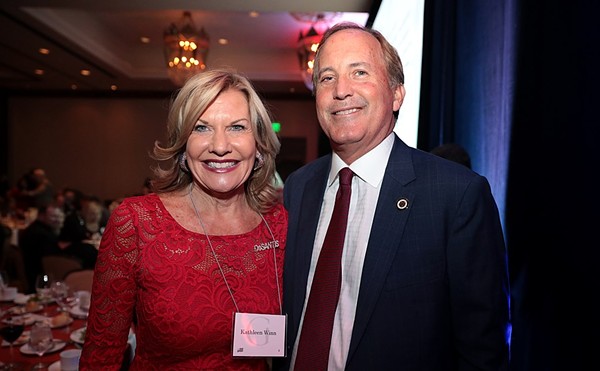What’s in a Name? San Antonio High School Names Raise Questions About Inclusivity and Representation
By Bekah McNeel on Fri, Jul 17, 2020 at 9:00 am
As the U.S. faces a moment of self-awareness, monuments to Confederate and colonial icons are becoming more difficult to defend. Bronze statues and marble cenotaphs have become lightning rods for cultural reckoning since their construction was often just as symbolic.
But other tributes are more complicated. Like high schools.
Highlighting that complication, the San Antonio area has 46 comprehensive public high schools. Of those, only one is named for a person of color. There’s a good chance you think it’s Marshall, but more on that later.
More of SA’s high schools — five, in fact — are named for people who enslaved people of color. Ironically, Marshall actually belongs in this category. Again, more on that later.
Before the who, what, when, where and why of San Antonio’s high school names, it’s worth asking whether high school names matter. Does it really matter whose name we’re screaming at a football game, wearing on T-shirts, or memorializing in song?
While we shouldn’t require perfection in the people we name things after, University of Arkansas researcher Jay P. Green says school names bear a symbolic significance.
“A school name is, at least in part, meant to convey to young people what each community values,” Green said, “It suggests that there is something about that person’s life that is worth learning and perhaps emulating.”
Absence of Latinx Names
So, who are the individuals that school boards past and present found worthy of emulation in this city where almost 70% of school age people are Latinx?
Well, for starters, none of them are Latinx.
Army Lt. Col. Karen Wagner is the single person of color among San Antonio high school namesakes. Wagner, a Black woman, was killed at the Pentagon in the September 11 attacks.
Eight high schools are named for places, such as East Central and Somerset. Southwest Legacy is named for an idea, while Memorial and Veterans Memorial are named for groups of people.
Meanwhile, Legacy of Educational Excellence, or L.E.E. — the school formerly named after Confederate General Robert E. Lee — is in a category publicly described by trustee Edd White as “lipstick on a pig.”
Three high schools are named for white women: educator Virginia Allred Stacey, Supreme Court Justice Sandra Day O’Connor and U.S. First Lady Lady Bird Johnson.
Named for White Men
That leaves us with 31 high schools, all named after white men either directly, or one degree removed. For instance, Judson’s first high school is named for its district. And that district is named for Moses Campbell Judson, who advocated for clean water, education and “family values,” according to the school’s website.
We also have a full bench of Supreme Court justices in Northside ISD; the real estate developer B.B. Harlan; a smattering of presidents, military heroes and educators; and political satirist Samuel Clemens. Churchill is the only high school named after a leader of another country.
San Antonio ISD’s grab bag of white guys also includes a philanthropist, an inventor and a botanist who dabbled in eugenics, not to mention Sam Houston and “poet of the Confederacy” Sidney Lanier.
SAISD briefly had a Phyllis Wheatley High School, which then merged with Brackenridge High School during desegregation. As consolation for closing the Black school, SAISD renamed Brackenridge for Wheatley, until 10 years later when white alumni demanded it be changed back to Brackenridge.
Naming and renaming a public school is like putting up and taking down a statue. There’s always a reason.
“Communities should deliberate about what values are important to them and then select names that somehow convey those values,” University of Arkansas’ Green said. “And when a community’s values change, the name names of schools should change.”
Following the explosive 1954 Brown v. Board of Education ruling that outlawed racial school segregation, naming a school for the General of the Confederate Army was a statement of values. Like in 1958, when NEISD did it.
Appeasement or Inclusivity
So too, new names send a message of new values.
Sometimes.
Other times, you get “lipstick on a pig.”
When the NEISD board chose to go with Legacy of Educational Excellence over, say Sheila Jackson Lee, Amy Freeman Lee, Harper Lee, or, hell, Spike Lee, it chose to value appeasement over inclusivity. Many rebrands go the similar route, opting for less new value and more neutralization.
“I see this avoidance of any potential controversy and picking names that don’t mean anything in particular to the community as a missed opportunity,” Green said. “It essentially says that the adults don’t really care what values are conveyed, which is itself a value that children pick up on.”
Conveying new values doesn’t have to be an act of contrition, either.
Thurgood Marshall, who famously argued and won Brown v. Board before becoming the first Black U.S. Supreme Court justice, meets all the criteria for a Northside high school namesake.
Alas, Northside already has a Marshall High School, named for John Marshall, fourth chief justice of the Supreme Court. It was named in 1960, before Thurgood Marshall was on the bench. And while John Marshall did enslave people, it wasn’t John Marshall’s raison d’être. He didn’t go to war for it.
To rename John Marshall on principle would mean renaming a lot of high schools. It’s unclear whether the revolution has appetite for that, though it does highlight the depth of the country’s human enslavement issue.
So, while cost-effective, to rename Marshall High School today would be an act of solidarity, not appeasement.
And if L.E.E. and Brackenridge are indicators, renaming any school is either brave or stupid, because the alumni army descends with furor over “erased histories,” both national and personal.
Laundering Process
That’s the laundering power of American history. Cities, counties, landmarks, developments and schools become part of history, and people get attached. The deeds of namesakes are rendered invisible by happy memories and spin-offs.
A statue of Jefferson Davis may be an easy target for removal in 2020, but what about Fort Davis, from whence we derive the Davis Mountains, Jeff Davis County and Fort Davis ISD? From those we further derive Fort Davis School and Davis Mountains State Park.
Robert E. Lee has the same setup in Coke County, as does Confederate Gen. Patrick Cleburne in his eponymous county.
High schools are part of that laundering process, because the high school as an institution becomes a source of identity and pride for the community — even those members who would never have been welcome by the namesake. We become wedded to a history in which thousands of school children must cheer the names of men who would not have seen them as equals.
Stay on top of San Antonio news and views. Sign up for our Weekly Headlines Newsletter.
But other tributes are more complicated. Like high schools.
Highlighting that complication, the San Antonio area has 46 comprehensive public high schools. Of those, only one is named for a person of color. There’s a good chance you think it’s Marshall, but more on that later.
More of SA’s high schools — five, in fact — are named for people who enslaved people of color. Ironically, Marshall actually belongs in this category. Again, more on that later.
Before the who, what, when, where and why of San Antonio’s high school names, it’s worth asking whether high school names matter. Does it really matter whose name we’re screaming at a football game, wearing on T-shirts, or memorializing in song?
While we shouldn’t require perfection in the people we name things after, University of Arkansas researcher Jay P. Green says school names bear a symbolic significance.
“A school name is, at least in part, meant to convey to young people what each community values,” Green said, “It suggests that there is something about that person’s life that is worth learning and perhaps emulating.”
Absence of Latinx Names
So, who are the individuals that school boards past and present found worthy of emulation in this city where almost 70% of school age people are Latinx?
Well, for starters, none of them are Latinx.
Army Lt. Col. Karen Wagner is the single person of color among San Antonio high school namesakes. Wagner, a Black woman, was killed at the Pentagon in the September 11 attacks.
Eight high schools are named for places, such as East Central and Somerset. Southwest Legacy is named for an idea, while Memorial and Veterans Memorial are named for groups of people.
Meanwhile, Legacy of Educational Excellence, or L.E.E. — the school formerly named after Confederate General Robert E. Lee — is in a category publicly described by trustee Edd White as “lipstick on a pig.”
Three high schools are named for white women: educator Virginia Allred Stacey, Supreme Court Justice Sandra Day O’Connor and U.S. First Lady Lady Bird Johnson.
Named for White Men
That leaves us with 31 high schools, all named after white men either directly, or one degree removed. For instance, Judson’s first high school is named for its district. And that district is named for Moses Campbell Judson, who advocated for clean water, education and “family values,” according to the school’s website.
We also have a full bench of Supreme Court justices in Northside ISD; the real estate developer B.B. Harlan; a smattering of presidents, military heroes and educators; and political satirist Samuel Clemens. Churchill is the only high school named after a leader of another country.
San Antonio ISD’s grab bag of white guys also includes a philanthropist, an inventor and a botanist who dabbled in eugenics, not to mention Sam Houston and “poet of the Confederacy” Sidney Lanier.
SAISD briefly had a Phyllis Wheatley High School, which then merged with Brackenridge High School during desegregation. As consolation for closing the Black school, SAISD renamed Brackenridge for Wheatley, until 10 years later when white alumni demanded it be changed back to Brackenridge.
Naming and renaming a public school is like putting up and taking down a statue. There’s always a reason.
“Communities should deliberate about what values are important to them and then select names that somehow convey those values,” University of Arkansas’ Green said. “And when a community’s values change, the name names of schools should change.”
Following the explosive 1954 Brown v. Board of Education ruling that outlawed racial school segregation, naming a school for the General of the Confederate Army was a statement of values. Like in 1958, when NEISD did it.
Appeasement or Inclusivity
So too, new names send a message of new values.
Sometimes.
Other times, you get “lipstick on a pig.”
When the NEISD board chose to go with Legacy of Educational Excellence over, say Sheila Jackson Lee, Amy Freeman Lee, Harper Lee, or, hell, Spike Lee, it chose to value appeasement over inclusivity. Many rebrands go the similar route, opting for less new value and more neutralization.
“I see this avoidance of any potential controversy and picking names that don’t mean anything in particular to the community as a missed opportunity,” Green said. “It essentially says that the adults don’t really care what values are conveyed, which is itself a value that children pick up on.”
Conveying new values doesn’t have to be an act of contrition, either.
Thurgood Marshall, who famously argued and won Brown v. Board before becoming the first Black U.S. Supreme Court justice, meets all the criteria for a Northside high school namesake.
Alas, Northside already has a Marshall High School, named for John Marshall, fourth chief justice of the Supreme Court. It was named in 1960, before Thurgood Marshall was on the bench. And while John Marshall did enslave people, it wasn’t John Marshall’s raison d’être. He didn’t go to war for it.
To rename John Marshall on principle would mean renaming a lot of high schools. It’s unclear whether the revolution has appetite for that, though it does highlight the depth of the country’s human enslavement issue.
So, while cost-effective, to rename Marshall High School today would be an act of solidarity, not appeasement.
And if L.E.E. and Brackenridge are indicators, renaming any school is either brave or stupid, because the alumni army descends with furor over “erased histories,” both national and personal.
Laundering Process
That’s the laundering power of American history. Cities, counties, landmarks, developments and schools become part of history, and people get attached. The deeds of namesakes are rendered invisible by happy memories and spin-offs.
A statue of Jefferson Davis may be an easy target for removal in 2020, but what about Fort Davis, from whence we derive the Davis Mountains, Jeff Davis County and Fort Davis ISD? From those we further derive Fort Davis School and Davis Mountains State Park.
Robert E. Lee has the same setup in Coke County, as does Confederate Gen. Patrick Cleburne in his eponymous county.
High schools are part of that laundering process, because the high school as an institution becomes a source of identity and pride for the community — even those members who would never have been welcome by the namesake. We become wedded to a history in which thousands of school children must cheer the names of men who would not have seen them as equals.
Stay on top of San Antonio news and views. Sign up for our Weekly Headlines Newsletter.
Tags:
- San Antonio,
- Texas,
- High School,
- high schools,
- school names,
- inclusivity,
- representation,
- Lt. Col. Karen Wagner,
- L.E.E.,
- Lee,
- NEISD,
- Legacy of Educational Excellence,
- Jay P. Green,
- Brackenridge,
- Phyllis Wheatley,
- SAISD,
- North East Independent School Distrcit,
- San Antonio Independent School District,
- Northside Independent School District,
- NISD

KEEP SA CURRENT!
Since 1986, the SA Current has served as the free, independent voice of San Antonio, and we want to keep it that way.
Becoming an SA Current Supporter for as little as $5 a month allows us to continue offering readers access to our coverage of local news, food, nightlife, events, and culture with no paywalls.
Scroll to read more San Antonio News articles
Newsletters
Join SA Current Newsletters
Subscribe now to get the latest news delivered right to your inbox.

















